Giovanni da Bologna

Giovanni da Bologna (* 1529 in Douai , County of Flanders in the Seventeen Provinces , today in the Nord department in France ; † August 13, 1608 in Florence ), actually Jean de Boulogne , known as Giambologna , was a Flemish-Italian sculptor from the Florentine School of Mannerism and early baroque .
He came from the county of Flanders, which was ruled by the House of Habsburg and reached far into what is now France, but was mainly active in Italy . His work can be assigned to Mannerism , a form of the late Renaissance . Giovanni Bologna made numerous sculptures and fountain figures for the Italian nobility, especially for the Medici . One of his students was the South German and Tyrolean sculptor Hans Reichle .
biography
Giovanni da Bologna began his training in Antwerp . After studying with the architect and sculptor Jacques du Broeucq , he moved to Italy in 1550 and studied in Rome, where he dealt extensively with the sculptures of classical antiquity. He was heavily influenced by Michelangelo but developed his own Mannerist style. Pope Pius IV gave Giovanni da Bologna his first major commission, the colossal bronze Neptune and minor figures for the Neptune Fountain in Bologna , for which Tommaso Laureti had designed the base in 1566. Giambologna spent his most productive years in Florence, where he had settled in 1553. In 1563 he was appointed a member (Accademico) of the prestigious Accademia delle Arti del Disegno in Florence , which was founded on January 13, 1563 by Duke Cosimo I de 'Medici under the influence of the painter-architect Giorgio Vasari . He became one of the most important court sculptors of the Medici. He died in Florence at the age of 79 - the Medici had never allowed him to leave Florence, fearing that either the Austrian or Spanish Habsburgs would lure him into permanent employment. Giovanni da Bologna was buried in a chapel he designed himself in the Santissima Annunziata .
plant
Giovanni da Bologna became known for his understanding of movement and the refined, differentiated surface treatment. One of his best known works is the Flying Mercury , of which he made four versions - Mercury stands on one foot and is supported by a zephyr. The god raises an arm to point to the sky in a gesture borrowed from the repertoire of classical rhetoric. His second famous work is The Rape of the Sabine Women (1574–82), a marble sculpture that is prominently placed in the Loggia dei Lanzi on the Piazza della Signoria in Florence. The three-figure sculpture was carved from a single piece of marble. The client was Francesco Medici, Grand Duke of Tuscany. Giovanni da Bologna's depictions of Venus established a canon of proportions and influenced two generations of sculptors in Italy.
Giovanni da Bologna also made many sculptures for garden grottos and fountains in the Boboli Gardens of Florence and in Pratolino, as well as the bronze doors of the Cathedral of Pisa. He created the bronze seahorses and several other sculptures for Bartolomeo Ammannati's Neptune Fountain, Florence. The equestrian statue of Cosimo I Medici, also in Florence, was completed by his assistant Pietro Tacca.
Giambologna shaped later sculptors through his students Adriaen de Vries and Pietro Francavilla, who left his studio in 1601 to go to Paris, and Pierre Puget , who spread Giambologna's influence throughout Northern Europe. Pietro Tacca took over Giovanni da Bologna's workshop in Florence and became a mediator for the following generation of sculptors.
Mars
In 1587, the artist gave the Mars statuette to the Saxon Elector Christian I when he took office. Until 1924 the small bronze was one of the main works of the electoral art chamber in Dresden, along with three other sculptures. As part of the compensation for the prince , the statuette was given to the Wettin family in 1924 as part of the compensation. When the Wettin family association offered bronze for sale a few years later, IG Farben co-founder Theodor Plieninger bought the statuette for the Griesheim-Elektron chemical factory . In 1988, Mars came into the possession of Bayer AG through two donations . Here it was initially part of the art collection and was repeatedly loaned out to exhibitions, including the art collection in Dresden . In mid-2018, Bayer AG commissioned the auction house Sotheby’s to auction the statuette, which led to a wave of protests in the art sector. The general director of the Staatliche Kunstsammlungen Dresden, Marion Ackermann , hoped that the work of the Italian Renaissance sculptor would come back to Dresden, where it had been for over three centuries. For years the art collection has tried in vain to win it back. Ackermann criticized the group's behavior: "On June 14, I wrote to the board of management that I was disappointed that there was no contact with us beforehand." On June 29, the chemist Peter Plieninger, great-grandson of Theodor Plieninger, and the artist Nicolaus wrote Schmidt wrote two open letters to Werner Baumann , CEO of Bayer AG. They asked Baumann to cancel the auction and instead donate the bronze “as a contribution to the European Cultural Heritage Year 2018 of Bayer AG to the Dresden State Art Collection.” Plieninger stated that his great-grandfather had not made the purchase of Mars as a “company investment, exactly how Bayer AG did not acquire the statuette, but received it as a gift. ”He reminded Baumann of the social responsibility of the“ world-class chemical company. ”The dispute over the planned auction at Sotheby's on July 4, 2018 was the first time Giovanni da Bologna was in Germany known to a wide audience.
The diverse media reports, the associated pressure on Bayer AG and the willingness of the Free State of Saxony and the federal government to provide funds for a purchase led Bayer AG to cancel the auction on July 2, 2018 and to sell the Dresden State Art Collection agreed. The General Director of the State Art Collections, Marion Ackermann, said she was happy that Giambologna's bronze had been won back for Saxony. Monika Grütters had previously sharply criticized Bayer AG's original plans to sell Giambologna's bronze as "a nationally important work of art at the highest price", especially since she was once given it herself ".
Statuettes at daytime in the Medici Chapel Florence by Michelangelo
In 2018, sculptures by Giambologna were shown in a special exhibition by the Dresden State Art Collections . Among the personifications of the times of day (morning, evening, day and night) in the Medici Chapel Florence of Michelangelo were to 1555/58 statuettes Alabaster created that to 1560/70 of Cosimo I de 'Medici to the Elector Augustus of Saxony paid were. The attribution of these sculptures to Giambologna's work is based on a relief "Allegory of Francesco de 'Medici " by Giambologna from the Prado Madrid and the selection of the material alabaster. Giambologna has artistically completed Michelangelo's partially unfinished sculptures in the statuettes in his sense.
Work overview (selection)
| image | title | Originated | Size, material | Location |
|---|---|---|---|---|

|
Florence wins over Pisa | Completed after 1570 | marble | Museo nazionale del Bargello , Florence |

|
Deianira, wife of Hercules, is kidnapped by the centaur Nessus | around 1620 | bronze | Louvre-Lens |

|
Triton | between 1560 and 1570 | bronze | |

|
Diavolino | bronze | Museo Bardini, Florence | |

|
Bacchus | bronze |
Museo nazionale del Bargello , Florence The picture shows a true-to-scale copy at the foot of the Rossi Cerchi tower near Ponte Vecchio in Florence. |
|

|
Thetis | 1580-1585 | ||

|
architecture | State Art Museum Copenhagen | ||
| link | Venus | 1573 | marble | Boboli Gardens , Florence |

|
Apollo | bronze | Palazzo Vecchio, Florence | |

|
astronomy | The design was created around the turn of the 16th and 17th centuries. Century (cast around 1624) |
bronze | |
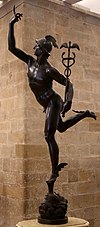
|
Flying Mercury | 1578 – approx. 1580 | bronze |
Bargello , Florence |

|
Fountain of Neptune | 1563-66 | Bronze and marble | Piazza del Nettuno, Bologna |
| link | Perseus | circa 1576 | marble | Boboli garden |

|
Hercules and the Centaur | 1600 | Marble 2.69 m |
Loggia dei Lanzi , Florence |

|
The fountain of the Oceanus | 1576 | marble | Boboli Gardens, Florence |

|
Bust of Francesco de Medici | modeled 1585–87 cast around 1611 by Pietro Tacca |
bronze | New York, Metropolitan Museum of Art |

|
The Apennines | between 1570 and 1579 | 10 m rock, lava, stone |
Park Demidoff |
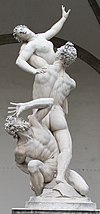
|
Robbery of the Sabine Women | 1579 | marble | Loggia dei Lanzi, Florence |

|
Samson kills a Philistine | circa 1560 | 2.10 m marble |
Victoria and Albert Museum , London |
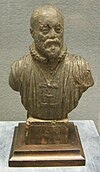
|
Self portrait | circa 1599 | wax | |

|
Ferdinand I. | |||

|
Equestrian monument to Ferdinand I. | bronze | Piazza Santissima Annuntiata, Florence | |

|
Equestrian monument to Cosimo I de Medici | 1587-94 4.50 m |
bronze | Piazza della Signoria, Florence |

|
Philip III from Spain | Cast by Pietro Tacca in 1616 | bronze | Plaza Mayor, Madrid |
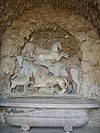
|
Animal grotto | In the garden of the Villa Medici of Castello | ||
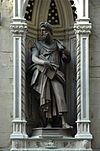
|
San Luca | bronze | Orsanmichele , Florence | |

|
Lion attack on a horse | Designed between 1580 and 1589 | 23.8 cm bronze |
Walters Art Museum |

|
Hercules with the Erymanthian boar | around 1575/1580 | 47.7 cm bronze |
Walters Art Museum |

|
Dwarf Morgante | 17th century | ||

|
The dwarf Morgante rides a kite | 29 cm bronze |
Paris The picture shows a copy in the Walters Art Museum. |
|

|
Striding horse | between 1595 and 1600 | Victoria and Albert Museum, London |
literature
- Dimitrios Zikos: Giambologna . In: General Artist Lexicon . The visual artists of all times and peoples (AKL). Volume 53, Saur, Munich a. a. 2007, ISBN 978-3-598-22793-6 , pp. 181-185.
- Charles Avery : Giambologna. The Complete Sculpture. Phaidon et al., Oxford 1987, ISBN 0-7148-8026-4 .
- Mary Weitzel Gibbons: Giambologna. Narrator of the Catholic Reformation (= California Studies in the History of Art. Vol. 33). University of California Press, Berkeley CA et al. 1995, ISBN 0-520-08213-3 .
- A. Rudigier, B. Truyols, with a foreword by B. Jestaz: Jean Bologne et les jardins d'Henri IV , Bulletin monumental 174, 3, 2016, pp. 247–373.
- A. Rudigier, B. Truyols: Giambologna. Court Sculptor to Ferdinando I. His art, his style and the Medici gifts to Henri IV , London 2019.
Web links
- Giovanni Bologna in the Artcyclopedia
- Literature by and about Giovanni da Bologna in the catalog of the German National Library
- Works in the European cultural portal Europeana
- Work in the object portal "museum-digital: westfalen
Notes and sources
- ^ R. Wellens: Jacques du Broeucq, sculpteur et architecte de la renaissance (Brussels) , 1962
- ^ Susan Horner, Joanna B. Horner, Walks in Florence and Its Environs, Volume 1, Smith, 1884, p. 199
- ↑ SKD Online Collection - Mars (accessed December 10, 2018)
- ^ Art Foundation K52, in full - two open letters to the Chairman of the Board of Management of Bayer AG
- ↑ Stuttgarter Zeitung of June 30, 2018, Resistance to the planned sale of valuable sculpture - accessed on July 1, 2018
- ^ Art Foundation K52, in full - two open letters to the Chairman of the Board of Management of Bayer AG
- ↑ Frankfurter Allgemeine Zeitung of June 30, 2018, Der Kriegsgott
- ↑ MDR-Kultur, "Dresdner Mars" saved from auction, July 2, 2018, 8:30 p.m. - accessed on July 2, 2018
- ↑ In the shadow of time. Giambologna, Michelangelo and the Medici Chapel (accessed August 23, 2018)
- ↑ Press conference on the exhibition: Shadows of Time. Giambologna, Michelangelo and the Medici Chapel (accessed August 23, 2018)
- ↑ Giambologna, Michelangelo and the Medici Chapel (accessed August 23, 2018)
- ↑ Wax model. Florence Triumphant over Pisa. Victoria and Albert Museum.
- ↑ The photo shows the plaster version in the Palazzo Vecchio , erected in 1565. Florence Triumphant over Pisa ( Memento from June 26, 2013 in the web archive archive.today )
- ↑ Comune Firenze ( Memento of March 6, 2014 in the Internet Archive )
- ↑ The base was designed by Tommaso Laureti .
- ↑ Francesco I de 'Medici. ( Memento from August 18, 2012 in the Internet Archive ) To Magnificenza! 2003.
- ^ 'Samson Slaying a Philistine', by Giambologna, 1560–2. Victoria and Albert Museum.
- ↑ The Dwarf Morgante Riding on a Dragon.
| personal data | |
|---|---|
| SURNAME | Giovanni da Bologna |
| ALTERNATIVE NAMES | Giambologna; Giovanni Bologna; Boulogne, Jean de |
| BRIEF DESCRIPTION | Mannerist sculptor |
| DATE OF BIRTH | 1529 |
| PLACE OF BIRTH | Douai |
| DATE OF DEATH | August 13, 1608 |
| Place of death | Florence |